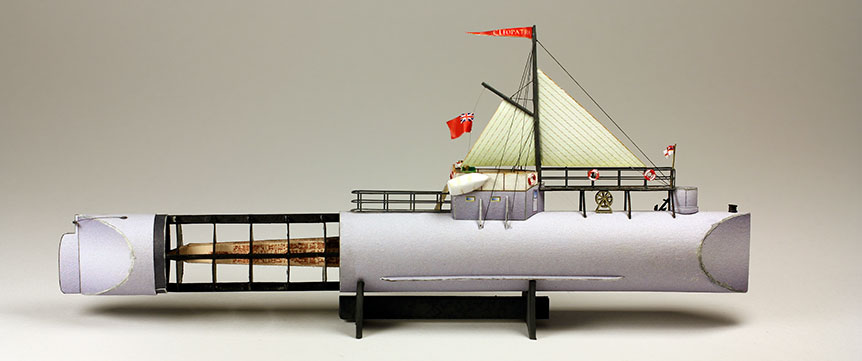
 Obelisk Barge "Cleopatra", 1878
Obelisk Barge "Cleopatra", 1878



Over the years, several schemes were devised to get the obelisk to London, none of which came to fruition. However, in 1877 the necessary elements to undertake the project, namely brains and money, came together in the shape of engineer John Dixon and distinguished and very wealthy Sir Erasmus Wilson. Dixon devised a plan for a 92-foot long, cylindrical barge that would completely encase the obelisk, to be towed to England by a tug boat. Sir Erasmus, who was a devoted freemason and so had a certain fondness for obelisks agreed to put up 15,000 pounds (about $2,000,000 in today's money) to finance the project.
The barge was built and shipped in sections to Alexandria, where the obelisk lay buried in sand on the beach. As the monument was unearthed, the barge was assembled around it. The giant cylinder was then rolled into the sea. A deck-house, rudder, and mast were fitted, and the little ship was christened Cleopatra. On September 21, 1877 the tug Olga towed Cleopatra out into the Mediterranean and began the journey back to England. Disaster struck on October 14, 1877. A violent storm caught the ships in the Bay of Biscay. Cleopatra rolled wildly and soon became utterly untenable. Six volunteers from the Olga, including the captain's son, manned a boat to rescue Cleopatra's crew of five and her captain. The boat capsized and all hands were lost. Unawares, the Olga sent another boat, which at length succeeded in taking off her crew. The barge was cut loose and quickly disappeared from sight. The Cleopatra was believed lost until the Glasgow steamer Fitzmaurice spotted her floating upright and apparently undamaged. Taken in the Spanish harbor of El Ferrol, Cleopatra underwent repairs. The tug Anglia was sent to retrieve her. The tow got underway on January 15, 1878. Cleopatra arrived at Gravesend, at the mouth of the River Thames, on January 21, 1878.
Amid great fanfare the obelisk, no known as "Cleopatra's Needle" was erected on the Thames embankment on September 12, 1878, almost a year after the voyage had begun. To extract the obelisk, the celebrated little barge that had attracted so much public attention was dismantled and unceremoniously sold for scrap.